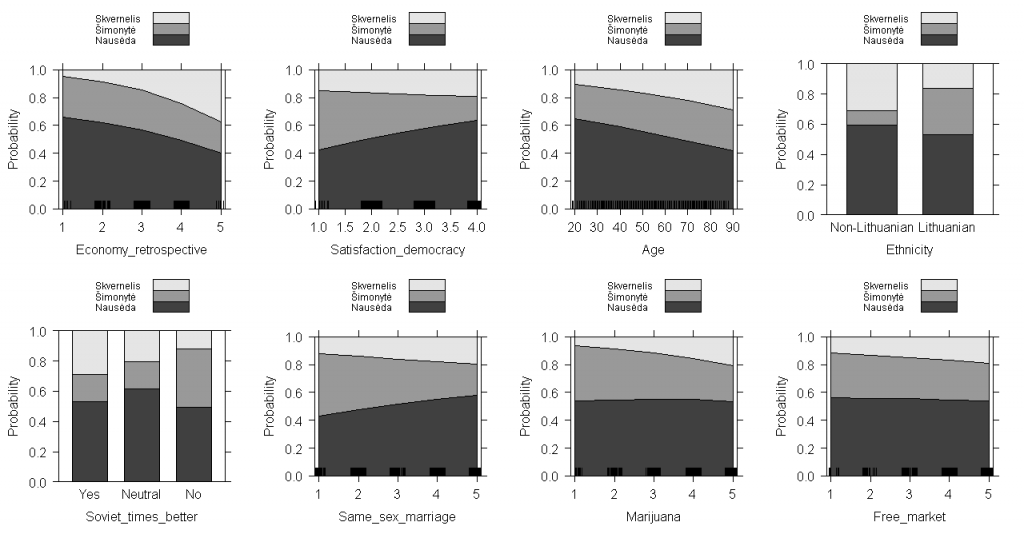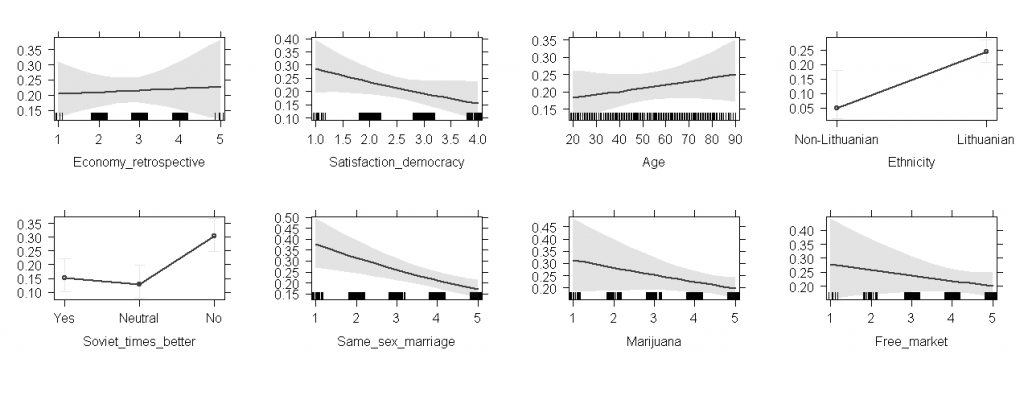Post developed by Mažvydas Jastramskis
Lithuanian presidential elections resemble first-order. First, citizens elect an executive that enjoys considerable powers. Lithuanian president is far from symbolic, her powers ranking average (Sedelius 2006; Raunio and Sedelius 2019) or even higher than average (Andrews and Bairett 2019) of the similar democracies in the region. Second, turnout in the first round of Lithuanian presidential elections (52.2% in 2014 and in 57.4% in 2019) is usually higher than in the parliamentary (50.6% in 2016 and 47.8% in 2020).
Presidential elections of 2019 is a convenient opportunity to analyse the behaviour of Lithuanian voters when selecting president. Differently from the 2009 and 2014 elections, when winner was clear from the beginning (president Dalia Grybauskaitė dominated these contests), first round in 2019 was quite competitive. According to the polls, three candidates were strong contenders for the second round: then-incumbent prime minister Saulius Skvernelis (supported by centre-left Lithuanian Farmers and Green Union), former finance minister Ingrida Šimonytė (supported by centre-right Homeland Union-Lithuanian Christian democrats) and former chief-economist in one of the major banks, Gitanas Nausėda. All three candidates were not party members, but whereas Skvernelis and Nausėda had clear ties with respective parties, only Nausėda was a real non-partisan. Nausėda and Šimonytė went to the second round, where the former secured victory with 65.7 % of votes.
Data from the 2019 post-election survey enables us to analyse what voters and motives were hiding beneath the results of the 2019 presidential elections (Jastramskis, 2020). In Figure 1, our dependent variable is vote choice between three main candidates (Skvernelis, Šimonytė and Nausėda) in the first round. Predicted probabilities are derived from multinomial logistic regression.
First, results show that cleavages previously found important in Lithuanian parliamentary elections, ethnicity and evaluation of Soviet times (Jastramskis et al. 2018), also influence vote choice in the presidential elections. While controlling for other variables, probability to vote for Šimonytė significantly decreases among the non-Lithuanians and vice versa – increases for Skvernelis.
As for anti-communist cleavage, Skvernelis fares best among those that agree with the statement that life under the Soviet times was better. Again, for Šimonytė trend is contrary – probability to vote for her is highest among the anti-communist segment of voters.
Second, our analysis shows signs that ideological cleavage related to social liberalism may becoming important in Lithuania. Probability to vote for Šimonytė decreases when the disagreement with the same-sex marriage grows.
Lastly, there are signs of retrospective voting, as the voters that evaluated the economy better were more inclined to vote for the presidential candidate of the governing coalition, Skvernelis. However, the overall effect is not strong.

Figure 1. Probability to vote for candidates in the first round of 2019 Lithuanian presidential elections (graphic based on multinomial logistic regression).
What about the second round of presidential elections? Two main cleavages retained the significance: as we can see from Figure 2, anti-communist and Lithuanian voters had higher probabilities to vote for Šimonytė than others (vote for Nausėda is a reference group). Same-sex marriage still made a difference: less liberal the voters, lesser probability to vote for Šimonytė (and higher – for Nausėda). However, as Skvernelis dropped from the race, retrospective economic evaluations did not affect the voting in second round: neither Šimonytė nor Nausėda could be “blamed” or “rewarded” for the economy.
Another interesting observation is influence of satisfaction with democracy – we can see the inverse relationship between this independent variable and probability to vote for Šimonytė. Non-partisanship status of Nausėda probably helped him to attract the voters with lower levels of political trust in the second round.

Figure 2. Probability to vote for Šimonytė in the second round of 2019 Lithuanian presidential elections (graphic based on binary logistic regression).
References:
Andrews, J. T. and R. L. Bairett. 2019. “Measuring Executive Power.” Working Paper.
Jastramskis, M. 2020. Kas už ką balsavo 2019 metų Lietuvos prezidento rinkimuose? [Who voted for Whom in the 2019 Lithuanian Presidential Elections?]. Politologija, 2020/1, 97, pp. 8–41.
Jastramskis, M., Kavaliauskaitė, J., Morkevičius, V., Petronytė Urbonavičienė I. and A. Ramonaitė. 2018. Ar galime prognozuoti Seimo rinkimus? Trijų kūnų problema Lietuvos politikoje [Can We Forecast Seimas Elections? The Three-Body Problem in Lithuanian Politics]. Vilnius: Vilnius University Press.
Raunio, T. and T. Sedelius. 2019. “Shifting Power-Centres of Semi-Presidentialism: Exploring Executive Coordination in Lithuania.” Government and Opposition 54 (4): 637-660.
Sedelius, T. 2006. The Tug-of-War Between Presidents and Prime Ministers: Semi-Presidentialism in Central and Eastern Europe. Örebro: Örebro Studies in Political Science 15.